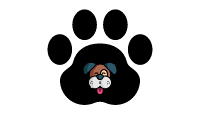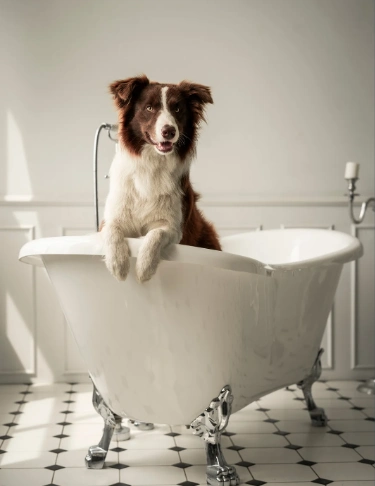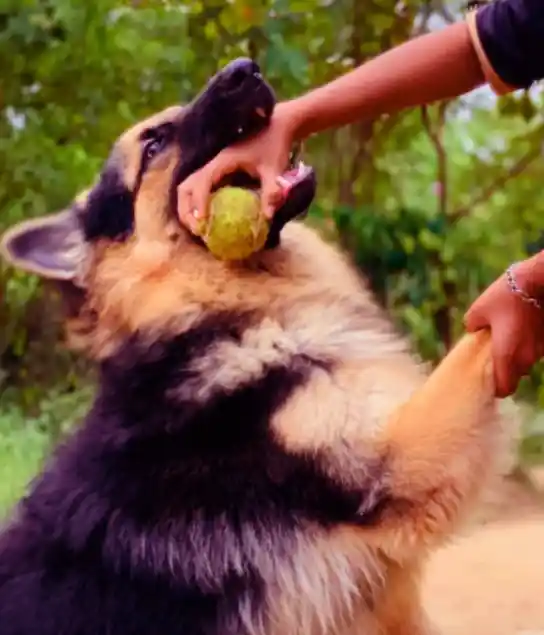Understanding The Dog Constipation Symptoms, Diagnosis, and Treatment
Constipation refers to infrequent, difficult, or seemingly incomplete defecation in dogs. Constipation affects approximately 13.5% of the 90 million pet dogs in the United States – over 12 million dogs. A 2022 clinical trial at the University of Tennessee Veterinary Medical Center tested a probiotic strain to prevent constipation in dogs. The probiotic helped increase the frequency of defecation and improved fecal consistency.
If a dog has not had a bowel movement in 24-48 hours, it may indicate constipation. Other symptoms include straining to defecate without production, small amounts of liquid feces, or hard dry stools. The normal range for a healthy dog is one bowel movement per day, with a consistency similar to toothpaste.
While occasional constipation may not be a concern, chronic or severe constipation is considered abnormal. The dog’s colon obstruction prevents it from passing feces or gas, causing severe constipation. It is a medical emergency requiring immediate veterinary assistance.
Several factors may cause constipation in dogs, including “dehydration, lack of exercise, anxiety, intestinal obstructions, hypothyroidism, and certain medications.” Treatment options include increasing water intake, adding fiber to the diet, exercise, laxatives, and enemas. Relieving constipation quickly reduces discomfort and prevents complications.
Monitoring your dog’s digestive health and bowel habits allows early detection and treatment of constipation. Pay attention to “signs of straining, frequent unsuccessful trips outside, dry stools, vomiting, lethargy, or loss of appetite.” Proactive care and vigilance can effectively manage constipation in dogs.
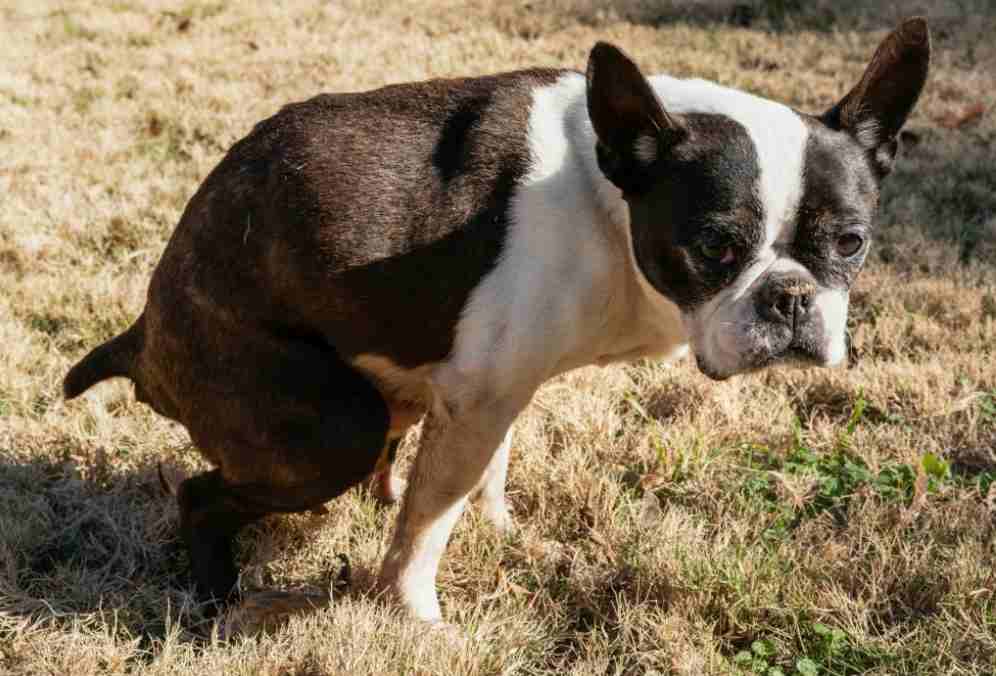
Table of Contents
- What are the reasons for constipation in dogs?
- The Main symptoms of canine constipation
- Home treatments and tips to help a constipated dog defecate
- Using canned pumpkin to help relieve constipation in dogs
- Natural remedies
- Feed a canned diet
- Include fiber and probiotics into a dog’s diet
- Keeping dogs well-hydrated
- Squirting water into a dog’s rectum
- Inserting an ice cube into a dog’s rectum
- Gently stimulating the anal region with wipes
- Manually stimulating a dog’s anus
- Consistent potty routine with exercise
- Constipation remedies to avoid for dogs
- Tips for training a dog to defecate on command
- FAQ
What are the reasons for constipation in dogs?
Constipation has numerous potential causes in canines. Diet is a significant factor, with low-fiber kibble being a common culprit. Most veterinarians recommend at least 5% crude fiber content in dog food. Insufficient hydration can also lead to constipation, as dogs require approximately 1 ounce of water per pound of body weight daily.
Medical conditions likely to cause constipation include:
- Intestinal obstructions (10-15% of cases) – foreign bodies, tumors, strictures
- Hypothyroidism (4% of constipation cases) – low thyroid hormone levels
- Spinal cord disease (2-3% of cases) – disk herniation, trauma
- Pelvic disorders – can impair defecation
- Anal gland impaction (13% of cases) – blocked anal sacs
Additionally, certain medications like “diuretics, anti-seizure medicines, and opioids” frequently cause constipation as a side effect in dogs.
Stress and anxiety related to changes in routine, environment, travel, or introducing new people/animals can also potentially lead to constipation by altering motility. Paying attention to “diet, hydration, and behavioral changes” can help identify factors contributing to constipation in a dog. Discussing causes with a veterinarian allows for customizing treatment accordingly. Addressing the underlying issue and symptomatic relief helps manage this common canine condition.
The Main symptoms of canine constipation
- Infrequent defecation – Healthy dogs typically defecate 1 or 2 times per day. Constipated dogs may only go once every 2-3 days.
- The dog experiences difficulty defecating – Strains, whimpers, and crouchs for long periods without success, Pushing with no result.
- Small amounts of liquid feces are little blobs of diarrhea-like stool rather than formed feces.
- Hard, dry stools – Stools are often dry, hard pellets that may be painful to pass. May see blood associated with strained defecation.
- Lack of stool production – No bowel movement in over 48 hours is abnormal.
- Distended abdomen – A blocked colon causes the belly to appear swollen or distended.
- Vomiting and loss of appetite – This can occur if intestinal obstruction or severe dehydration occurs.
- Lethargy or restlessness – The dog may act uncomfortable or unwell.
- Scooting – Dog drags rear end along the ground to relieve discomfort.
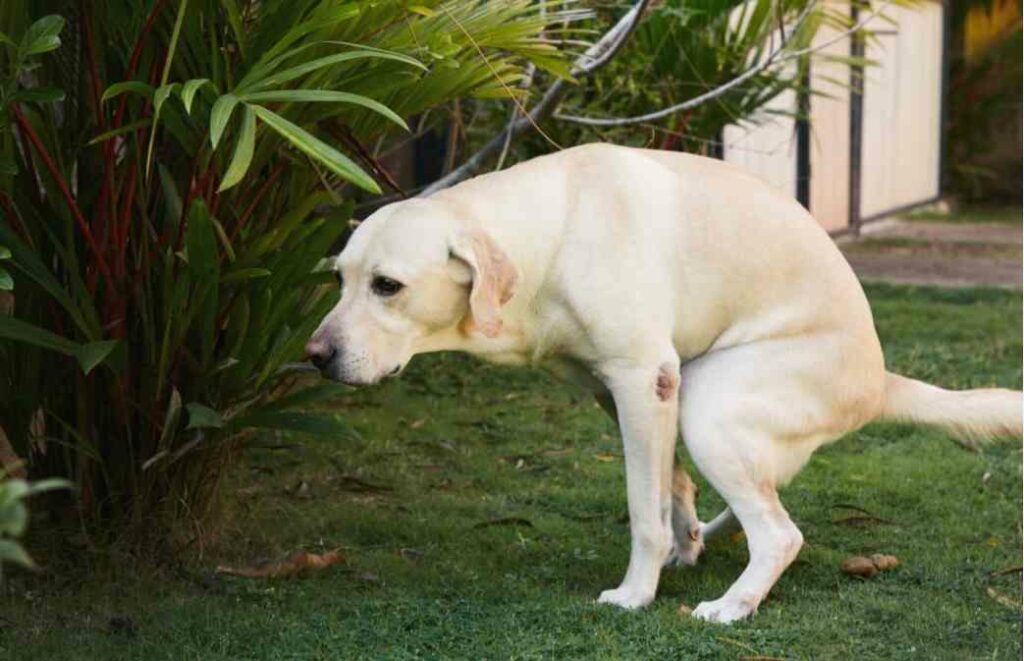
Paying attention to “stool frequency, consistency, and defecation difficulty” allows early identification of constipation. Seeking veterinary advice after 48 hours without a bowel movement is recommended. Prompt treatment improves comfort and prevents complications.
Home treatments and tips to help a constipated dog defecate
- Increase hydration – Add water to food or use low-sodium chicken/beef broth to increase fluid intake. The goal is ~1 oz per lb of body weight daily.
- Add fiber – “Mix pumpkin puree, bran, or Metamucil” into food. Gradually increase fiber to 5-10% of diet over 2-3 days. Too much too fast can cause diarrhea.
- Exercise – Walks and play can stimulate gut motility. Avoid intense exercise that stresses the abdomen.
- Massage abdomen – Gentle clockwise massage around the colon may stimulate bowel movement.
- Warm compress – Apply a warm towel or heating pad set on low to the abdomen. Improves blood flow.
- Glycerin suppositories – Lubricate and stimulate the rectum. Follow package instructions.
- Laxatives – A veterinarian may recommend stool softeners or osmotic agents.
- Enemas – If suppositories are ineffective, vets may administer medicated enemas.
If there is no improvement within 12-24 hours or the dog seems distressed, take them to the vet immediately. Severe constipation can rapidly become an emergency. Quick action reduces the risk of lasting complications.
Using canned pumpkin to help relieve constipation in dogs
Canned pureed pumpkin (not pie filling) is an effective home remedy for constipation in dogs due to its high fiber and water content. Pumpkin is a natural source of soluble fiber, which absorbs water in the intestinal tract and softens stools. It also contains vitamins A, E, C, potassium, and iron that support digestive health.
The recommended dosage of canned pumpkin for dogs is,
- Small dogs (under 10 lbs) – 1 teaspoon
- Medium dogs (11-25 lbs) – 1-2 tablespoons
- Large dogs (26-50 lbs) – 2-4 tablespoons
- Giant dogs (over 50 lbs) – 4-5 tablespoons

Pumpkin should be pureed, not pie filling, with no added sugars, spices, or salt. Introduce it gradually mixed into dog food and increase over 2-3 days. Provide plenty of fresh water.
Monitor stool consistency and adjust dosage as needed. Long-term use is safe if controlled.
Canned pumpkin can provide a gentle, effective boost in fiber to help relieve constipation and get things moving naturally. Consult your veterinarian if constipation persists beyond 2-3 days of treatment.
Natural remedies
Natural remedies that can help relieve constipation in dogs.
- Leafy greens – Fiber-rich vegetables like “spinach, kale, carrots, and broccoli” can stimulate bowel movements. Steamed/cooked is best. The dose is ~1 tsp per 10 lbs body weight.
- Coconut oil – Contains medium-chain triglycerides that lubricate the intestines. Give 1/4 tsp per 10 lbs diluted in food. Has 124 cal per tsp – monitor weight.
- Olive oil – also lubricates the colon. The dose is 1-2 tsp for small dogs and 1 tbsp for large dogs. High in calories – 113 per tbsp.
- Ginger – Anti-inflammatory properties ease digestion and stimulate motility. Give 1/4 tsp minced ginger per 10 lbs body weight.
- Flaxseed – Rich in “fiber, omega-3s, and lignans”. Start with 1 tsp ground flaxseed per meal, gradually increase to 1 tbsp.
- Bone broth – Provides hydration. Low-sodium chicken or beef broth, 1-4 oz, depending on the dog’s size.
Introduce new foods gradually. Monitor stool consistency and hydration status. Consult a vet if there is no improvement in 1-2 days. Natural remedies can effectively and safely treat mild constipation alongside increased fluids, exercise, and monitoring.
Feed a canned diet
Using a canned dog food diet can be an effective way to help relieve and prevent constipation in dogs. Here are some tips:
- Canned food typically has a moisture content of around 75-85%, compared to only 10-12% in dry kibble. The extra fluid softens stools.
- Look for canned foods with added fiber sources like “pumpkin, peas, sweet potatoes, oat bran, or psyllium.” Fiber gives stools more bulk.
- Gradually transition over 3-7 days by mixing a little canned food into the kibble, increasing the canned ratio daily.
- Feed a blend of canned and dry if switching entirely to canned is impractical. The extra moisture still helps.
- Stick to name-brand foods meeting AAFCO standards. Avoid inferior brands with fillers and artificial ingredients.
- Adjust amounts fed to maintain ideal body weight, as canned food is more calorically dense than kibble.
Check with your veterinarian before changing your dog’s diet, especially for dogs with certain health conditions. The increased moisture and fiber in canned food can significantly improve colon function and make defecation easier for chronically constipated dogs.
Include fiber and probiotics into a dog’s diet
Look for dog foods with at least 5% crude fiber from sources like “rice bran, beet pulp, and oat fiber.” Gradually transition to a high-fiber formula.
- Mix 1⁄4-1 tsp of psyllium husk powder per meal as a fiber supplement. Start low to avoid diarrhea.
- Add probiotic supplements or raw goat’s milk to provide 2-5 billion CFUs daily.
- Give 1-2 tbsp of plain, unsweetened yogurt for natural probiotics. Avoid added sugars.
- Try prebiotic fibers like chicory root or fructooligosaccharides to feed good gut bacteria.
- Offer high-fiber fruits & veggies like “raspberries, apples, spinach, and carrots.” Limit to 10% of diet.
- Consider probiotic treats like Purina Pro Plan FortiFlora bars that supply live cultures.
Consult a vet before significant diet changes. Gradually transition fiber and probiotic sources while monitoring stool quality. A balanced diet supports healthy digestion and prevents constipation episodes.
Keeping dogs well-hydrated
Scientists at the University of Bologna in Italy published a study in 2017 on the use of fermented soybean products to prevent constipation in dogs. They found that a soybean supplement increased fecal moisture content and reduced constipation in dogs.

- Provide fresh, clean drinking water at all times. Change water daily.
- Add water, broth, or no-salt chicken/beef stock to dry kibble to increase moisture intake.
- Offer ice cubes or frozen broth cubes as hydrating treats.
- Feed canned food, which has high water content (~75-85%).
- Include water-rich fruits and veggies like “melons, cucumbers, and tomatoes.”
- Use a water fountain to encourage drinking. Flowing water attracts dogs.
- Try electrolyte supplements like Pedialyte if dehydrated. Give according to package.
- Monitor urine color – light lemonade color indicates good hydration.
- Watch for excessive thirst, which can indicate kidney issues.
Adequate hydration softens stools, improves colon function, and prevents constipation. Ensure access to clean drinking water and provide moisture through diet. Proper hydration supports canine health. Consult your vet if constipation persists despite increased hydration.
Squirting water into a dog’s rectum
Water should be near body temperature, around 100-102°F (37.8° – 39°C). Avoid cold water shock. Use an animal enema bulb syringe explicitly designed for rectal hydration and gently insert the tip. Never force the syringe in deeply. Squirting water into a dog’s rectum should only be done with extreme caution and proper technique, as there are risks involved.
Gently agitate the syringe to stimulate defecation hydrostatically. Apply low pressure. Start with small amounts of water, around 30-60mL, and repeat if needed. Too much can cause damage. To avoid irritating the rectal lining, one must use proper lubrication. The vet recommends using KY jelly or surgical lubricant.
Stop immediately if the dog “cries in pain, bleeds, or does not pass stool.” Seek veterinary advice. Only attempt this after other failed treatments and under a vet’s guidance. It can harm the colon if done improperly.
This technique should be an absolute last resort for experienced owners. Improper squirting of water can perforate the colon. Safer options include “lubricants, suppositories, pumpkins, and hydration.” Consult a veterinarian before attempting rectal hydration at home.
Inserting an ice cube into a dog’s rectum
Rectal administration of any object can damage the delicate rectal lining, causing bleeding or perforation. Ice can fracture inside the colon, causing lacerations. Melting ice also rapidly cools the body.
Struggling or straining during administration may worsen constipation or lead to injury. Inserting anything into the rectum requires extreme care and appropriate lubricant to avoid trauma. This technique is considered an outdated and inhumane practice with more risks than benefits.

Safer, gentler options for relieving constipation include:
- Increasing hydration and fiber in the diet
- Giving stool softeners or laxatives under a vet’s direction
- Trying probiotics and physical activity to stimulate bowel motility
- Using glycerin suppositories to lubricate and induce defecation
If your dog experiences constipation for more than 1-2 days, veterinarians highly recommend seeking veterinary assistance. Never insert foreign objects into a dog’s rectum without guidance. Focus on safe, effective ways to relieve constipation and restore normal bowel function. Inserting an ice cube into a dog’s rectum carries risks and is not recommended as a constipation remedy.
Gently stimulating the anal region with wipes
Gently stimulating the anal region with wipes may provide some relief for a constipated dog, but there are some critical caveats. Wipes must be expressly formulated for pet use, not baby wipes, to avoid irritation or toxicity if ingested.
Circular wiping motions should be very gentle to avoid damaging the rectal tissues. Never scrub forcefully. Ensure wipes are free of alcohol, perfumes, or other chemicals that could burn or sting sensitive areas.
- To insert any objects into the rectum, one still needs to use proper lubrication. Never insert dry.
- Wiping should stimulate the area but never forcefully penetrate the anal opening.
- Stop if the dog shows any signs of pain or distress.
- Before resorting to insertion methods, individuals should try other remedies first.
While external wiping can sometimes stimulate a bowel movement, most veterinarians recommend starting with “dietary changes, stool softeners, exercise, and hydration.” Never put anything inside a dog’s rectum without proper training. Consult a vet if constipation persists beyond 1-2 days.
Manually stimulating a dog’s anus
Inserting anything into the rectum requires extreme care and appropriate lubricant to avoid lacerations. The anal sphincter and rectal lining are very delicate tissues easily damaged if handled roughly. Struggling during the process could worsen constipation or cause rectal prolapse.
A 2015 study by veterinary researchers at the University of Cambridge examined the use of human laxatives to treat constipation in dogs. They found that laxatives containing polyethylene glycol were effective in treating constipation in dogs, with few side effects.
Strong manual pressure could perforate the colon, leading to fatal sepsis. This technique should only be performed by a licensed veterinarian and generally with sedation.
Safer constipation remedies for the home include:
- Adding fiber and moisture to the diet
- Giving laxatives or suppositories if prescribed by a vet
- Encouraging exercise and play to stimulate bowel motility
- Warm compresses and abdominal massage
- Monitoring for underlying health issues
Manually stimulating a dog’s anus carries significant risks and should only be attempted under veterinary guidance. Focus on gentler ways to relieve constipation. If ineffective after 1-2 days, take your dog to a vet for proper treatment.
Consistent potty routine with exercise
Consistent potty routine with exercise is an excellent way to help prevent and manage constipation in dogs. Researchers at the University of Florida College of Veterinary Medicine did a study in 2022 on risk factors for constipation in dogs. Breeds with higher risk included “French Bulldog, Pug, and Pekingese”. Being overweight and lack of exercise also increases risk.
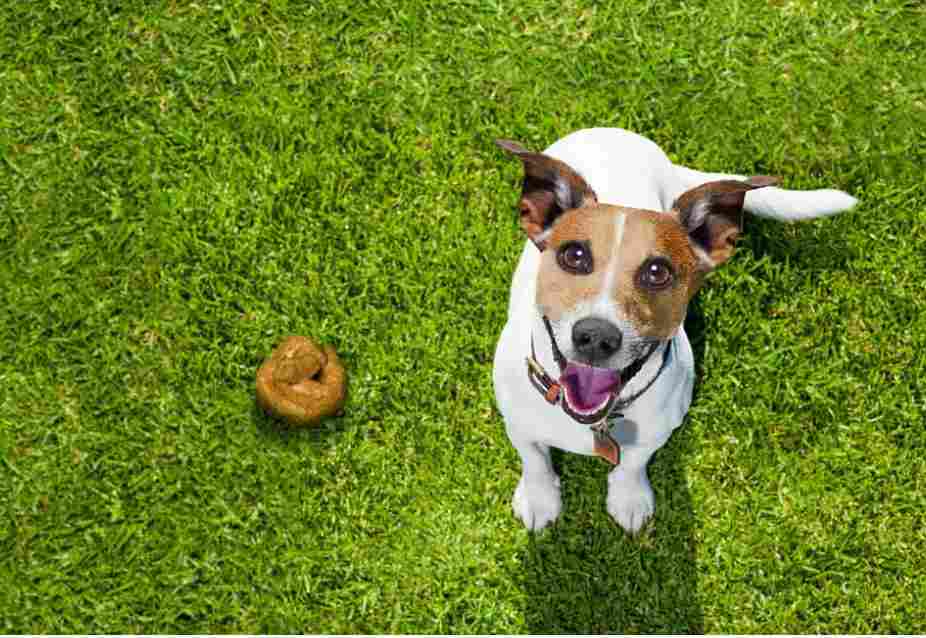
- Take dogs out consistently – after meals, upon waking, before bed – so they associate those times with defecating.
- Walking and light exercise stimulates intestinal motility and the gastrocolic reflex to promote bowel movements.
- Movements tend to occur 20-30 minutes after eating. Allow time after meals before walks.
- Use a command like “Go potty” to connect the behavior with the act of defecating.
- Reward with praise and treats when they eliminate during the potty break.
- Stick to the same route and potty spot, as dogs prefer familiar areas.
- For severe constipation, exercise may need to be restricted until the colon recovers.
- Never exercise right before or after eating to avoid bloat risk.
A predictable, consistent potty routine with post-meal exercise provides dogs with the movement and motivation needed to maintain regular bowel habits. Preventative routines are essential for healthy defecation.
Constipation remedies to avoid for dogs
- Human laxatives – Formulas meant for people can be unsafe or toxic to dogs. Avoid these.
- Home enemas – Improper administration can cause rectal tears or perforate the colon. Have a vet perform.
- Cereal – Can dehydrate dogs and often lacks adequate fiber. Not an effective remedy.
- Milk of Magnesia – Can cause electrolyte imbalances in high doses. Only use under veterinary direction.
- Suppositories – Please obtain approval from a veterinarian before administering, as they may be contraindicated for specific conditions.
- Massage with excessive pressure – Can potentially worsen obstructions or damaged tissues.
- Forcing exercise – Can stress the colon if severely constipated. Restrict activity until improved.
- Ice or cold water – Risk of thermal injuries and shock to the rectum. Use caution.
- Manual stimulation – Only attempt under guidance to avoid trauma and complications.
Focus on safer options like “dietary adjustments, stool softeners, warm compresses, and monitoring hydration.” If constipation is severe or persists for more than 1-2 days, seek veterinary advice before attempting home remedies.
www.puppiesdiary.com
Tips for training a dog to defecate on command
- Start training early as a puppy when they are most receptive. Adult dogs can learn, but puppies adapt fastest.
- Choose a one or two-word command like “Poop” or “Do your business.” Be consistent.
- Watch for signs they need to go – circling, sniffing, heading to the door. Take them out preemptively.
- Use the command when they begin to poop. Praise and reward with treats immediately after.
- Gradually give the command before they poop to establish an association. Reward every success.
- Stick to a consistent potty schedule around meals, naps, and exercise to encourage regularity.
- Have patience. This training may take weeks or months, depending on age and breed aptitude.
- Never scold or punish for accidents. Remain positive and keep sessions brief.
Training bowel movement on cue takes time but provides functional control for potty trips and constipation relief. Consistency, patience, and positive reinforcement are critical to success.
Benefits to training a dog to defecate on command
- Makes potty training easier – Establishes a clear routine and expectations for elimination.
- More controlled pooping – Prevents surprise poops in undesirable locations.
- Convenience for owner – Avoids long waits outside for the dog to go.
- Portability – Useful when traveling or in places with limited outdoor access.
- Health monitoring – Can identify constipation or other bowel issues sooner.
- Therapeutic purposes – Service dogs must be able to poop when working.
- Competition or show dogs – Handlers need control over the timing of elimination.
- Elderly or ill dogs – Ensures ability to poop when required.
- Inclement weather – Avoids long outdoor waits in rain, snow, heat, etc.
Having a dog poop on command takes effort but provides benefits for “sanitation, convenience, health monitoring, and unique working roles.” It adds an extra level of control and understanding between owner and dog.
FAQ
How Often Should a Dog Poop Per Day?
Optimal Frequency Depends on “Breed, Size, and Diet.” The number of times a healthy dog should defecate per day can range from 1 to 5 times, with the average being 2 or 3 bowel movements. This frequency depends on the dog’s size, age, activity level, and diet.
For example, a large 50 lb Labrador that eats 2 cups of kibble per day may poop 3 times daily. In contrast, a smaller 15 lb Terrier eating 1/2 cup of food might only go once or twice. Puppies and senior dogs also tend to poop more often.
Turning to diet, dogs fed a raw or fresh food diet might poop less, with smaller and less smelly stools. This is because their food contains less filler and is more digestible. Kibble-fed dogs produce larger poops with more waste.
What are the Signs of Abnormal Pooping Habits in Dogs?
Irregular pooping habits in your dog could signal health issues. For instance, diarrhea or loose stools point to possible gastrointestinal problems. Constipation or hard, dry poops could mean dehydration or obstruction.
Not pooping for over 48 hours is also concerning and may indicate blockage. If your dog isn’t pooping normally, contact your vet. Track any changes to catch problems early.
Do Dog Potty Training Sprays Work?
Evidence Is Lacking. There is no solid scientific proof that commercial dog potty training sprays are effective. These products claim to attract dogs to eliminate in a designated area using pheromones or scents, but no studies confirm this.
It’s doubtful these sprays will potty train your pup. Simply use positive reinforcement instead. Or try water or an ice cube to encourage pooping. But consult your vet if your dog has ongoing potty training difficulties.
